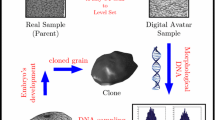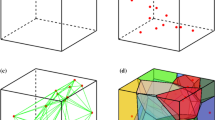Abstract
We introduce an improved version of a computational algorithm that “clones”/generates an arbitrary number of new digital grains from a sample of real digitalized granular material. Our improved algorithm produces “cloned” grains that more accurately approach the morphological features displayed by their parents. Now, the “cloned” grains were also included in a discrete element method simulation of a triaxial test and showed similar mechanical behavior compared to the one displayed by the original (parent) sample. Thus, the present work is divided in four parts. First, we compute multivariable probability density functions from the parents’ morphological parameters (morphological DNA), i.e., aspect ratio, roundness, volume-surface ratio, and particle diameter. Second, an improved, now parallelized and better tuned version of the geometric stochastic cloning algorithm (Jerves et al. in Granul Matter, 2017. https://doi.org/10.1007/s10035-017-0716-7), which is based on the aforementioned multivariable distributions and that, in the same way, introduces an enhanced radii sampling process, as well as a new quality control test based on the volume-surface ratio is discussed. Third, morphological DNA of the grains (i.e., aspect ratio, roundness, volume-surface ratio and particle diameter) is also extracted from the new “cloned” grains and compared to the one obtained from the parent sample. Fourth, clones and parents are subjected to a triaxial compression tests using a level set discrete element scheme (3DLS-DEM), and then, compared in terms of their mechanical response. Finally, the error of the “clones” in the morphology and mechanical behavior is analyzed and discussed for future improvements.

















Similar content being viewed by others
References
Cundall, P.A., Strack, O.D.L.: A discrete numerical model for granular assemblies. Gotechnique 29, 47–65 (1979). https://doi.org/10.1680/geot.1979.29.1.47
Cundall, P.A., Hart, R.: Numerical modeling of discontinua. Eng. Comput. 9(2), 101–113 (1972). https://doi.org/10.1108/eb023851
Seyedi Hosseininia, E.: Investigating the micromechanical evolutions within inherently anisotropic granular materials using discrete element method. Granul. Matter 14(4), 483–503 (2012). https://doi.org/10.1016/0148-9062(88)92293-0
Barla, G., Einstein, H., Kovari, K.: Manuscripts using numerical discrete element methods. Rock Mech. Rock Eng. 46(4), 655–655 (2012). https://doi.org/10.1007/s00603-013-0442-3
Lu, J., Zhang, C., Jian, P.: Meso-Structure Parameters of Discrete Element Method of Sand Pebble Surrounding Rock Particles in Different Dense Degrees., pp. 871–879. Springer, Berlin (2016). https://doi.org/10.1007/978-981-10-1926-5_91
Huang, X., OSullivan, C., Hanley, K., Kwok, C.: Capturing the state-dependent nature of soil response using DEM. In: Geomechanics from Micro to Macro, pp. 61–65. https://doi.org/10.1201/b17395-10 (2014)
Lim, K., Andrade, J.: Granular element method for three-dimensional discrete element calculations. Int. J. Numer. Anal. Methods Geomech. 38(2), 167–188 (2013). https://doi.org/10.1002/nag.2203
Lim, K., Andrade, J.: Discrete modeling of granular media: a NURBS-based approach. https://thesis.library.caltech.edu/8734/61/lim_kengwit_2015_thesis.pdf (2015)
Cundall, P.: Formulation of a three-dimensional distinct element model. Part I. A scheme to detect and represent contacts in a system composed of many polyhedral blocks. Int. J. Rock Mech. Min. Sci. Geomech. Abstr. 25(3), 107–116 (1988). https://doi.org/10.1016/0148-9062(88)92293-0
Vlahini, I., Kawamoto, R., And, E., Viggiani, G., Andrade, J.: From computed tomography to mechanics of granular materials via level set bridge. Acta Geotech. 12(1), 85–95 (2016). https://doi.org/10.1007/s11440-016-0491-3
Andrade, J.E., Lim, K., Avila, C.F., Vlahini, I.: Granular element method for computational particle mechanics. Comput. Methods Appl. Mech. Eng. 241–244, 262–274 (2012). https://doi.org/10.1016/j.cma.2012.06.012
Jerves, A., Kawamoto, R., Andrade, J.: Effects of grain morphology on critical state: a computational analysis. Acta Geotech. 11(3), 493–503 (2015). https://doi.org/10.1007/s11440-015-0422-8
Khalili, M., Brisard, S., Bornert, M., Aimedieu, P., Pereira, J., Roux, J.: Discrete digital projections correlation: a reconstruction-free method to quantify local kinematics in granular media by X-ray tomography. Exp. Mech. 57(6), 819–830 (2017). https://doi.org/10.1007/s11340-017-0263-5
Kim, K., Zhuang, L., Yang, H., Kim, H., Min, K.: Strength anisotropy of berea sandstone: results of X-ray computed tomography, compression tests, and discrete modeling. Rock Mech. Rock Eng. 49(4), 1201–1210 (2015). https://doi.org/10.1007/s00603-015-0820-0
Fu, X., Dutt, M., Bentham, A., Hancock, B., Cameron, R., Elliott, J.: Investigation of particle packing in model pharmaceutical powders using X-ray microtomography and discrete element method. Powder Technol. 167(3), 134–140 (2006). https://doi.org/10.1016/j.powtec.2006.06.011
Cundall, P.A., Hart, R.: A computer model for simulating progressive, large scale movements in blocky rock systems. In: Proceedings of the International symposium Rock Fracture, ISRM, Nancy, II-8, vol 2 (1971)
ASTM: Standard Guide for Computed Tomography (CT) Imaging, ASTM Designation E 1441 - 92a. In: 1992 Annual Book of ASTM Standards, Section 3 Metals Test Methods and Analytical Procedures. ASTM, Philadelphia, pp. 690–713 (1992)
Ketcham, R.A., Carlson, W.D.: Acquisition, optimization and interpretation of X-ray computed tomographic imagery: applications to the geosciences. Comput. Geosci. 27, 381–400 (2001)
Wang, L., Park, J., Fu, Y.: Representation of real particles for DEM simulation using X-ray tomography. Constr. Build. Mater. 21(2), 338–346 (2007). https://doi.org/10.1016/j.conbuildmat.2005.08.013
Jin, C., Yang, X., You, Z.: Automated real aggregate modelling approach in discrete element method based on X-ray computed tomography images. Int. J. Pavement Eng. (2015). https://doi.org/10.1080/10298436.2015.1066006
Kawamoto, R., And, E., Viggiani, G., Andrade, J.: All you need is shape: Predicting shear banding in sand with LS-DEM. Journal Of The Mechanics And Physics Of Solids (2018). https://doi.org/10.1016/j.jmps.2017.10.003
Kawamoto, R., And, E., Viggiani, G., Andrade, J.: Level set discrete element method for three-dimensional computations with triaxial case study (2016). https://doi.org/10.1016/j.jmps.2016.02.021
Kawamoto, R., And, E., Viggiani, G., Andrade, J.: All you need is shape: predicting shear banding in sand with LS-DEM. J. Mech. Phys. Solids 111, 375–392 (2018). https://doi.org/10.1007/s11440-015-0405-9
Robert, C.: Monte Carlo Methods, pp. 1–13. Wiley, New York (2016). https://doi.org/10.1002/9781118445112.stat03876.pub2
Jerves, A., Kawamoto, R., Andrade, J.: A geometry-based algorithm for cloning real grains. Granul. Matter (2017). https://doi.org/10.1007/s10035-017-0716-7
Mathworks.com: Parallel Computing Toolbox—MATLAB (2017). https://www.mathworks.com/products/parallel-computing.html
Alba, E., Troya, J.: Analyzing synchronous and asynchronous parallel distributed genetic algorithms. Future Gener. Comput. Syst. 17(4), 451–465 (2001). https://doi.org/10.1016/s0167-739x(99)00129-6
Bertsekas, D., Castaon, D.: Parallel synchronous and asynchronous implementations of the auction algorithm. Parallel Comput. 17(6–7), 707–732 (1991). https://doi.org/10.1016/s0167-8191(05)80062-6
Jung, G., Gnanasambandam, N., Mukherjee, T.: Synchronous parallel processing of big-data analytics services to optimize performance in federated clouds. In: 2012 IEEE Fifth International Conference on Cloud Computing (2012) https://doi.org/10.1109/cloud.2012.108
Borrelli, F., Bemporad, A., Morari, M.: Geometric algorithm for multiparametric linear programming. J. Optim. Theory Appl. 118(3), 515–540 (2003). https://doi.org/10.1023/B:JOTA.0000004869.66331.5c
La.mathworks.com: Interpolation Methods- MATLAB & Simulink- MathWorks America Latina. https://la.mathworks.com/help/curvefit/interpolation-methods.html. Accessed 12 Apr 2018 (2018)
Grama, A., Anshul, G., Karypis, G., Kumar, V.: Introduction to Parallel Computing, 2nd edn. Addison-Wesley, Boston (2003)
Blaise, B.: Introduction to Parallel Computing. https://computing.llnl.gov/tutorials/parallel_comp/#Models. Accessed 3 Sep 2018 (2018)
Elprin, N.: Easy Parallel Loops in Python, R, Matlab and Octave.https://blog.dominodatalab.com/simple-parallelization/. Accessed 3 Sept 2018 (2018)
Hussaini, M., Leer, B., Van Rosendale, J.: Upwind and High-Resolution Schemes, p. 303. Springer, Berlin (1997)
Borja, R.: J2 Plasticity, pp. 31–58. Springer, Berlin (2013). https://doi.org/10.1007/978-3-642-38547-6_3
Brainerd, W.S.: Object-oriented programming. In: Guide to Fortran 2008 Programming, Springer, London (2015) https://doi.org/10.1007/978-1-4471-6759-4_12
Dovey, J., Furrow, A.: Object-oriented programming. In: Beginning Objective-C, Apress, Berkeley, CA (2012). https://doi.org/10.1007/978-1-4302-4369-4_2
Craig, I.: Object-Oriented Programming Languages: Interpretation (2007). https://doi.org/10.1007/978-1-84628-774-9
Poo, D., Kiong, D., Ashok, S.: Object-Oriented Programming and Java (2008). https://doi.org/10.1007/978-1-84628-963-7
NVIDIA Developer: CUDA Zone. https://developer.nvidia.com/cuda-zone. Accessed 2 May 2018 (2018)
Zheng, J., Hryciw, R.D.: Traditional soil particle sphericity, roundness and surface roughness by computational geometry. Géotechnique 65(6), 494–506 (2015). https://doi.org/10.1680/geot.14.P.192
Zheng, J., Hryciw, R.: A corner preserving algorithm for realistic DEM soil particle generation. Granul. Matter 18(4), 64 (2016). https://doi.org/10.1007/s10035-016-0679-0
Acknowledgements
This work was possible thanks to the research computing facilities (Quinde) and advisory services offered by the Scientific Computing Laboratory of the Research Center on Mathematical Modeling: MODEMAT, Escuela Politécnica Nacional-Quito and the facilities as well as support of Yachay E.P. with their supercomputer Quinde 1 at Urcuqui, Imbabura, Ecuador. The authors also want to recognize and thank the help provided by Reid Y. Kawamoto (California Institute of Technology, USA), and Lino M. Mediavilla (Universidad San Francisco de Quito, Ecuador) without whom compiling and running the 3D LS-DEM C++ code [21] used for the triaxial compression test simulations would have not been possible.
Author information
Authors and Affiliations
Corresponding author
Ethics declarations
Conflict of interest
The authors declare that they have no conflict of interest.
Rights and permissions
About this article
Cite this article
Medina, D.A., Jerves, A.X. A geometry-based algorithm for cloning real grains 2.0. Granular Matter 21, 2 (2019). https://doi.org/10.1007/s10035-018-0851-9
Received:
Published:
DOI: https://doi.org/10.1007/s10035-018-0851-9




